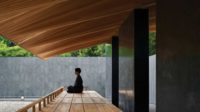Daikanyama Tsutaya Books
Like an Open Book: Klein Dytham architecture composed an airy three-building campus - an ode to the printed page - for Japanese media giant Tsutaya.












Architects & Firms
Tokyo
Bookstores may be closing right and left in cities all over the world, but in January 2012 Tokyo welcomed Daikanyama Tsutaya Books with an enthusiastic embrace. A new, 140,000-volume shop designed by the Tokyo-based firm Klein Dytham architecture (KDa), the building started out as a rebranding project for the media giant Tsutaya, which has 1,440 bookstores and CD-rental outlets throughout Japan. In addition to upgrading the company image, it resulted in a novel retail destination.
From competition to completion, the project took just 20 months, despite delays during construction caused by the 2011 earthquake. KDa's winning solution entailed three discrete, staggered volumes connected by a web of external walks and internal axes. Known for eye-popping elevations and clever contextual engagement, the architects got their conceptual foothold from the Tsutaya logo: a bold yellow T on a cobalt-blue background. “It was obvious what to do in three minutes,” says KDa principal Mark Dytham.
To refer to the logo, large Ts adorn the three glass, shedlike spaces. Each large T is composed of small ones carved from glass-reinforced concrete. Nodding politely to the 45,274-square-foot site's surroundings–an elegant, leafy avenue in front, residential and small-scale commercial development in back, and Fumihiko Maki's Hillside Terrace complex next door–the letters subtly act as signage but are fully integrated with the architecture. While the large Ts' horizontal flanges turn into screening devices that wrap the building tops, their vertical spines correlate with the central cores running the length of each building.
The entire shop is equally accessible from all sides, thanks to 14 entrances distributed around its perimeter. (In Japan, where theft is rare, security is not an issue.) “It's a really permeable thing,” explains Dytham. Inside, a matrix defined by the central cores and “Magazine Street,” a 20-foot-wide corridor containing 30,000 periodicals, divides the ground floor into 11 discrete book-sales areas, a café, and a convenience store. The second floor holds six music spaces in the east wing, six film sections in the west wing, and a lounge in the two-story middle building. The third floors of the two end buildings contain rental apartments. Escalators, copper-clad stairs, and elevators link the levels, while the exterior walks at grade level and covered bridges at the second floor unite the three structures.
Unlike other large bookshops, Daikanyama Tsutaya does not carry a broad inventory. Instead, it caters to the predilections of 50-somethings–Japan's largest population segment. “With the kids gone, they have more time and money to hang out and shop,” explains Dytham. Accordingly, the store stocks carefully chosen books and merchandise related to art, architecture, design, cooking, photography, cars, travel, and other topics of appeal to that age group. In addition, each section employs concierges, or specialists in their subject matter who offer advice, source hard-to-find titles, and even, in the case of the travel section, book hotel reservations.
The unique book selection, the high level of service, and the extended business hours (the shop is open daily from 7 a.m. to 2 a.m.) are not the only reasons people of all ages are flocking to the store. “The client envisioned a new cultural center, kind of like a living room for Tokyo,” says Dytham. In keeping with this concept, KDa chose warm, friendly materials and fashioned custom furniture and lighting to match.
Blending inside and out, exterior stone pavers become interior flooring and the full-height glass skin yields light-filled, airy spaces where the ceiling soars to 11 feet. To preserve this openness, KDa lined the window walls with movable furnishings, such as shelves, seats, lamps of various shapes, and, in the music areas, listening tables, which clip onto the building's steel-frame structure. Overhead, large, lanternlike pendant fixtures provide soft lighting while masking exposed ductwork and steel decking. By contrast, the book areas within the cores, where the ceiling drops to 9 feet, are lined with unpolished wood flooring and shelves to create “bookstore-y feel,” says Dytham.
Though there is nothing nostalgic about Daikanyama Tsutaya, the shop's mission is “welcome back books,” Dytham says. In both conceptual and concrete terms, it acknowledges the simple pleasure of reading and browsing for books–a shortcoming of e-commerce and even e-books. “Even in Japan, a country with a highly developed Internet culture, people like to touch things, to own things,” concludes the architect.
Formal name of building: Daikanyama Tsutaya Books
Location: Daikanyama, Shibuya-ku, Tokyo, Japan
Completion Date: January 2012
Gross square footage: 5,607.47 sqm
People
Owner:
Architect:
Personnel in architect's firm who should receive special credit:
Architect of record:
Interior designer:
Engineer(s):
Consultant(s):
Landscape:
Lighting: Other:
Signage:
Art Curation:
General contractor:
Photographer(s):
CAD system, project management, or other software used: |
Products
Structural system:
Manufacturer of any structural components unique to this project:
Exterior cladding:
Rainscreen:
Precast concrete:
Roofing:
Windows:
Glazing:
Skylights:
Doors: Metal doors:
Steel doors:
Sliding doors:
Fire-control doors, security grilles:
Hardware:
Security devices:
Other special hardware:
Interior finishes:
Cabinetwork and custom woodwork:
Paints and stains:
Interior Flooring:
Exterior Flooring:
Carpet:
Special interior finishes unique to this project:
Furnishings:
Lighting:
Conveyance: |













